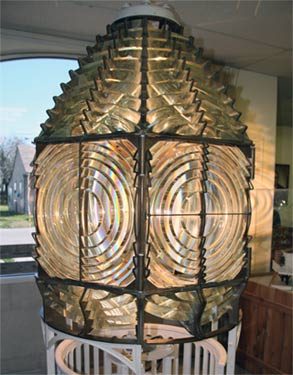
Lighthouse Lens on Display
LITTLE KNOWN MUSEUMS WILL ASTONISH Y0U
By Bob Jamison
Texas has an unlimited supply of interesting facts simply waiting for your discovery. What an opportune time to find out more about out state than to use these ‘dog-days’ of the hot summer to peruse our own history.
In the south east part of Texas near Liberty, you will find many artifacts and documents relating to Texas history then and now. It is the Sam Houston Library and Research Center. Also, there is an exact replica of the Texas Governor’s mansion built there by the late Price and Jean Daniel. Former governor Daniel has written a book on the history of the mansion and information is available there.
But going ever further back in our history than likely the best known San Jacinto battle grounds, you can take a short journey to one of the most historically significant areas which are surprisingly, Matagorda Bay. Surrounded by the once dreaded Karankawa Indians, battles unfamiliar to many have been recorded since the landing of LaSalle in 1685.
Ironically, the dangerous engagements with these Indians by French explorer LaSalle began with a cordial welcome near Alligator Point (now Port O’Conner, TX). The Indians must have been amused by the strange looking white men sailing into Pass Cavallo in a great “canoe”. By mostly hand signals, the Indians offered to help them hunt and fish in their dug-out canoes. Instead, LaSalle had his men take a couple of canoes from them to do the same. However, this understandably ended in bad blood. In fact it was the blood of some of the takers.
Today, one of the museums on the ‘must see’ is none other than the Calhoun County museum in Port Lavaca, TX. Inside you will get a compact video history of LaSalle’s epic adventure to find the Mississippi River through a warm water passage from France through the Gulf of Mexico. Many artifacts are on display from the fairly recent discovery and recovery of LaSalle’s ship, The LaBelle.
An example of the many artifacts from the ill fated ship LaBelle, is a hand made grenade. It is made of clay ball and contained flammable oil. Inside the outer portion is another explosive device with a fuse. When the outer portion’s fuse is ignited, it is tossed (usually) on the deck of an attacking boat and breaks spreading burning oil over the deck. The explosive device’s fuse is then ignited and the explosion kills or injures those trying to douse the flames.
Nearby on the western shores of Matagorda Bay between Port O’Conner and Port Lavaca, remains the ghost town of the once major sea port, Indianola. Its name comes from “Indian and Ola (the word for wave or hello in Spanish). It was once the thriving city that even had a rail road extending out into the deeper area of the bay to receive cargo and persons arriving from many parts of Europe. Indianola is now a small fishing village and has a beautiful beach with picnic shelters.
The peaceful blue waters of Matagorda Bay belies the turmoil of two devastating hurricanes that killed most of its citizens of Indianola and washed at least two city blocks into the sea. A stature of LaSalle stands tall there as he gazes out to Matagorda Bay and Pass Cavallo.
In more recent years during the Civil War, Union soldiers camped near the Indianola area. Just prior to the time of their occupation of this district, they had bombarded Port Lavaca with a barrage from Union Navy war ships. But little is heard of this today even by some local citizens.
So, take a short trip into our history. Who knows, you might get invited to view likely the only remaining Karankawa dug-out canoe in the museum warehouse. It awaits funds to restore it to its original likeness. However, most of its twenty two feet of once a log is very evident though not on public display yet.